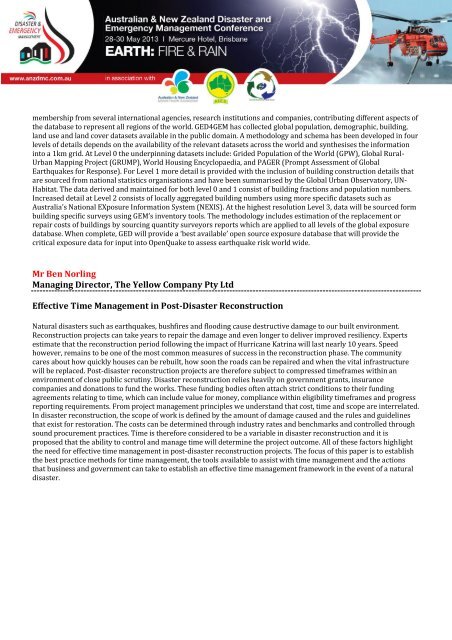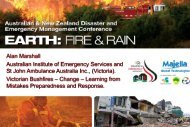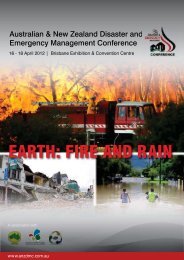Book of Abstracts 2013 - Australian and New Zealand Disaster ...
Book of Abstracts 2013 - Australian and New Zealand Disaster ...
Book of Abstracts 2013 - Australian and New Zealand Disaster ...
Create successful ePaper yourself
Turn your PDF publications into a flip-book with our unique Google optimized e-Paper software.
membership from several international agencies, research institutions <strong>and</strong> companies, contributing different aspects <strong>of</strong><br />
the database to represent all regions <strong>of</strong> the world. GED4GEM has collected global population, demographic, building,<br />
l<strong>and</strong> use <strong>and</strong> l<strong>and</strong> cover datasets available in the public domain. A methodology <strong>and</strong> schema has been developed in four<br />
levels <strong>of</strong> details depends on the availability <strong>of</strong> the relevant datasets across the world <strong>and</strong> synthesises the information<br />
into a 1km grid. At Level 0 the underpinning datasets include: Grided Population <strong>of</strong> the World (GPW), Global Rural-<br />
Urban Mapping Project (GRUMP), World Housing Encyclopaedia, <strong>and</strong> PAGER (Prompt Assessment <strong>of</strong> Global<br />
Earthquakes for Response). For Level 1 more detail is provided with the inclusion <strong>of</strong> building construction details that<br />
are sourced from national statistics organisations <strong>and</strong> have been summarised by the Global Urban Observatory, UN-<br />
Habitat. The data derived <strong>and</strong> maintained for both level 0 <strong>and</strong> 1 consist <strong>of</strong> building fractions <strong>and</strong> population numbers.<br />
Increased detail at Level 2 consists <strong>of</strong> locally aggregated building numbers using more specific datasets such as<br />
Australia’s National EXposure Information System (NEXIS). At the highest resolution Level 3, data will be sourced form<br />
building specific surveys using GEM’s inventory tools. The methodology includes estimation <strong>of</strong> the replacement or<br />
repair costs <strong>of</strong> buildings by sourcing quantity surveyors reports which are applied to all levels <strong>of</strong> the global exposure<br />
database. When complete, GED will provide a ‘best available’ open source exposure database that will provide the<br />
critical exposure data for input into OpenQuake to assess earthquake risk world wide.<br />
Mr Ben Norling<br />
Managing Director, The Yellow Company Pty Ltd<br />
Effective Time Management in Post-<strong>Disaster</strong> Reconstruction<br />
Natural disasters such as earthquakes, bushfires <strong>and</strong> flooding cause destructive damage to our built environment.<br />
Reconstruction projects can take years to repair the damage <strong>and</strong> even longer to deliver improved resiliency. Experts<br />
estimate that the reconstruction period following the impact <strong>of</strong> Hurricane Katrina will last nearly 10 years. Speed<br />
however, remains to be one <strong>of</strong> the most common measures <strong>of</strong> success in the reconstruction phase. The community<br />
cares about how quickly houses can be rebuilt, how soon the roads can be repaired <strong>and</strong> when the vital infrastructure<br />
will be replaced. Post-disaster reconstruction projects are therefore subject to compressed timeframes within an<br />
environment <strong>of</strong> close public scrutiny. <strong>Disaster</strong> reconstruction relies heavily on government grants, insurance<br />
companies <strong>and</strong> donations to fund the works. These funding bodies <strong>of</strong>ten attach strict conditions to their funding<br />
agreements relating to time, which can include value for money, compliance within eligibility timeframes <strong>and</strong> progress<br />
reporting requirements. From project management principles we underst<strong>and</strong> that cost, time <strong>and</strong> scope are interrelated.<br />
In disaster reconstruction, the scope <strong>of</strong> work is defined by the amount <strong>of</strong> damage caused <strong>and</strong> the rules <strong>and</strong> guidelines<br />
that exist for restoration. The costs can be determined through industry rates <strong>and</strong> benchmarks <strong>and</strong> controlled through<br />
sound procurement practices. Time is therefore considered to be a variable in disaster reconstruction <strong>and</strong> it is<br />
proposed that the ability to control <strong>and</strong> manage time will determine the project outcome. All <strong>of</strong> these factors highlight<br />
the need for effective time management in post-disaster reconstruction projects. The focus <strong>of</strong> this paper is to establish<br />
the best practice methods for time management, the tools available to assist with time management <strong>and</strong> the actions<br />
that business <strong>and</strong> government can take to establish an effective time management framework in the event <strong>of</strong> a natural<br />
disaster.






